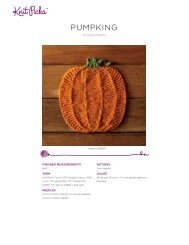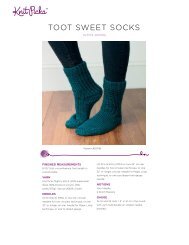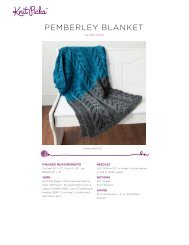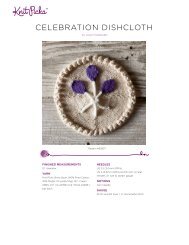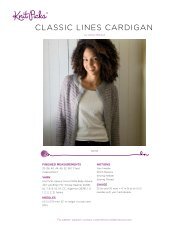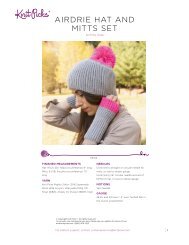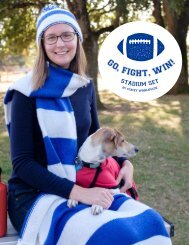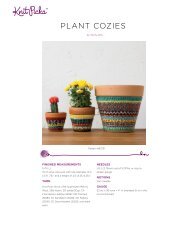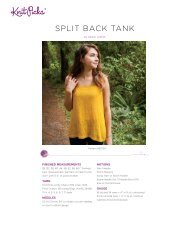Create successful ePaper yourself
Turn your PDF publications into a flip-book with our unique Google optimized e-Paper software.
GIANT ARM KNIT BUNNY<br />
by anne weil<br />
Imagine riding a gigantic <strong>bunny</strong> across<br />
the country side? Your kiddo will be over<br />
the moon with this fabulous oversized<br />
<strong>bunny</strong>. Let her imagination run wild while<br />
she snuggles and plays with her new<br />
favorite pal.<br />
Copyright 2015 Anne Weil<br />
www.flaxandtwine.com<br />
This pattern is for home use only, not for resale.
GIANT ARM KNIT BUNNY<br />
skill level<br />
Intermediate<br />
techniques<br />
:: Arm Knitting (See Arm Knitting How To PDF)<br />
:: Increase stitches (see page 4)<br />
:: Decrease stitches (see page 4)<br />
:: Mattress stitch (see page 5)<br />
materials<br />
:: Stuffing for head and body. Try quilting batting or old blanket<br />
or alternative down comforter in the color of yarn.<br />
:: 2 large black buttons<br />
:: 30-50 yds(27-47 m) of super bulky yarn for tail and nose.<br />
:: 5 yards 18 gauge wire for ears (optional)<br />
large <strong>bunny</strong><br />
730 yds (667m) of super bulky yarn (minimum of 2.0 stitches to<br />
the inch or fewer in traditional <strong>knit</strong>ting gauge). Hold 4 strands<br />
at one time. 4 x 185 yard (169 m) lengths req’d (instructions<br />
how to add yarn mid-project in Arm Knitting How-To PDF)<br />
small <strong>bunny</strong><br />
360 yds (329m) of super bulky yarn that is a minimum of 2.0<br />
stitches to the inch (or fewer) in traditional <strong>knit</strong>ting gauge.<br />
Hold 4 strands. 4 x 90 yard (82 m) lengths for pattern.<br />
tools<br />
:: darning needle<br />
:: piece of 4x5 inch cardboard for pom-pom tail<br />
:: scissors<br />
pattern<br />
large <strong>bunny</strong><br />
Body:<br />
Cast on 14 sts, leaving two yds to seam up the <strong>bunny</strong>.<br />
Knit 2 rows.<br />
Row 3: Increase 1 stitch at each end (16 sts).<br />
Knit 3 rows.<br />
Row 7: Increase 1 stitch at each end (18 sts).<br />
Knit 3 rows.<br />
Row 11: Increase 1 stitch at each end (20 sts).<br />
Knit 3 rows.<br />
Row 15: Increase 1 stitch at each end (22 sts).<br />
Knit 15 rows.<br />
Bind off. Set aside body piece.<br />
Head:<br />
Cast on 8 stitches.<br />
Knit for 7 rows.<br />
Dec. at each end of next row by <strong>knit</strong>ting two sts tog (k2tog) (6 sts).<br />
Dec. at each end of following row by k2tog (4 sts).<br />
Knit 1 row.<br />
Increase at each end of next row (6 sts).<br />
Increase at each end of following row (8 sts).<br />
Knit 7 rows.<br />
Keep 8 stitches on your <strong>arm</strong> and continue pattern making ears.<br />
pg 2<br />
yarn used<br />
large <strong>bunny</strong><br />
:: 6 skeins Cascade Magnum in Ecru, 123 yd (112.5m), 8.82 oz<br />
(250g), 100% wool for large <strong>bunny</strong><br />
:: 1 skein Madelinetosh ASAP in Molly Ringwald, 90 yd (82<br />
m),3.5oz (100g)<br />
small <strong>bunny</strong><br />
:: 8 skeins Blue Sky Alpaca Bulky in Porcupine (45 yd [41m]/<br />
31⁄2 oz [100g]) 50% alpaca/ 50% wool<br />
sizes and measurements<br />
20” widex36’” long x 18” high (o.6m w x 1.2m l x 0.5m h)<br />
abbreviations<br />
K: <strong>knit</strong>, P: purl; K1: <strong>knit</strong> 1 stitch, P1: purl 1 stitch; Sts:<br />
stitches; K2tog: <strong>knit</strong> 2 stitches together; Dec: Decrease<br />
yarn preparation<br />
Work with 4 strands of super bulky yarn at the same time.<br />
With the cascade magnum, I wound all the skeins into balls<br />
at the beginning. The <strong>bunny</strong> body takes approximately<br />
140-yards of 4 strands held together, so you will need the<br />
next two skeins before you’re done <strong>knit</strong>ting the body. To<br />
create four strands from my two extra skeins, I <strong>knit</strong> with the<br />
strand from the center and the strand from the outside of<br />
the wound ball at the same time. If you can’t work directly<br />
from the skeins, it may be easiest to divide your additional<br />
skeins in half (by measuring or by weight) before you start,<br />
so you always have 4 strands of yarn at hand to work with .<br />
Copyright 2015 flax & twine<br />
This pattern is for home use only, not for resale.
pattern ctd.<br />
Ears<br />
Remove the work from your <strong>arm</strong> and turn<br />
the piece around so the purl side is facing<br />
you. Put the first 4 sts onto a piece of<br />
scrap yarn or paper towel tube (A).<br />
Place the next 4 sts onto your right <strong>arm</strong><br />
with the working yarn at your hand (B).<br />
Knit 1 row.<br />
Knit 1, K2 tog, <strong>knit</strong> 1 (3 sts).<br />
Knit 1, increase 1 stitch, <strong>knit</strong> 1, increase 1<br />
stitch, <strong>knit</strong> 1 (5 sts).<br />
Knit 4 rows.<br />
k2 tog, <strong>knit</strong> 1, k2tog (3 sts).<br />
Knit 1, k2tog (2 sts).<br />
Pull yarn through last two stitches (C).<br />
Place the 4 sts on your holder back on to<br />
your right <strong>arm</strong>. Bring new yarn into your<br />
right hand (D) and follow the steps above<br />
for the second ear. Weave in all ends.<br />
GIANT ARM KNIT BUNNY<br />
pg 3<br />
A B C D<br />
E F G H<br />
Body Assembly<br />
:: Lay out body piece with purl side up<br />
with the wider part towards you (E).<br />
:: Fold center of bottom edge towards<br />
middle forming two legs (F).<br />
:: Seam bottom legs together with the<br />
mattress stitch, sewing underneath a<br />
stitch on the left (G) then a stitch on the<br />
right (H) up the length of the leg.<br />
:: Fold center of top edge towards middle<br />
forming two front legs (I).<br />
:: Seam front legs together with the<br />
mattress stitch.<br />
:: Stuff body with quilting batting or twin<br />
alternative down comforter in color of<br />
yarn (if desired, wrap batting or filling in<br />
fabric in color of yarn). Seam up belly with<br />
mattress stitch (J).<br />
:: Fold back legs up towards front of<br />
<strong>bunny</strong> and secure to body with yarn (K).<br />
:: Weave in all ends.<br />
I<br />
J K L<br />
M N O P<br />
Head Assembly<br />
:: Fold head in half with ears in front (L).<br />
:: Use cast on tail to seam together sides of head with mattress stitch (M).<br />
:: Stuff head with quilting batting (wrap batting in fabric in color of yarn) and use mattress stitch to seam top of head (N).<br />
:: Use 4 strands of yarn to attach head to body by sewing around the head collecting a stitch from the head and a stitch from<br />
the body, creating a neck (O). Secure additionally to position head.<br />
:: Bring base of ears together with a loop of knotted yarn (P). Weave in all ends.<br />
:: Sew button eyes on to face. Embroider yarn in contrasting color multiple times across one stitch to create nose.<br />
:: Make a large pom pom for tail by wrapping 40 yards of yarn around 5” piece of cardboard. Remove cardboard. Tightly tie a<br />
short piece of yarn around center of bundle. Cut loop ends on both sides and trim to desired shape. Attach to <strong>bunny</strong> bottom.<br />
:: Optional: To allow ears to stand up and be shaped, thread wire in and around the stitches of the outside of each ear. Tuck in<br />
ends.<br />
Copyright 2015 flax & twine<br />
This pattern is for home use only, not for resale.
GIANT ARM KNIT BUNNY<br />
pg 4<br />
SMALL BUNNY PATTERN<br />
Assembly instructions are the same as for large <strong>bunny</strong>.<br />
Body<br />
Cast on 10 sts, leaving two yds to seam up the <strong>bunny</strong>.<br />
Knit 2 rows.<br />
Row 3: Increase 1 stitch at each end (12 sts).<br />
Knit 2 rows.<br />
Row 6: Increase 1 stitch at each end (14 sts).<br />
Knit 1 row.<br />
Row 8: Increase 1 stitch at each end (16 sts).<br />
Knit 11 rows.<br />
Bind off. Set aside body piece.<br />
Head<br />
Cast on 6 sts.<br />
Knit for 5 rows.<br />
Dec. 1 st at each end of next row by <strong>knit</strong>ting two sts together<br />
(k2tog) (4 sts).<br />
K1, K2tog, K1 (3 sts).<br />
Knit 1 row.<br />
Increase at beginning of next row (4 sts).<br />
Increase at each end of following row (6 sts).<br />
Knit 5 rows.<br />
Keep 6 sts on your <strong>arm</strong> and continue pattern making ears.<br />
Ears<br />
Remove the work from your <strong>arm</strong> and turn the piece around so<br />
the purl side is facing you. Put the first 3 sts onto a piece of<br />
scrap yarn or paper towel tube.<br />
Place the next 3 sts onto your right <strong>arm</strong> with the working yarn<br />
at your hand. Knit 1 row.<br />
K2 tog, <strong>knit</strong> 1 (2 sts).<br />
Knit 1, increase 1 stitch, <strong>knit</strong> 1 (3 sts).<br />
Knit 3 rows.<br />
k2 tog, <strong>knit</strong> 1 (2 sts).<br />
Pull yarn through last two stitches.<br />
Place the 3 sts on your holder back on to your right <strong>arm</strong>. Bring<br />
new yarn into your right hand and follow the steps above for<br />
the second ear. Weave in all ends. Assemble small <strong>bunny</strong> in<br />
same manner as large <strong>bunny</strong>.<br />
techniques<br />
increasing stitches<br />
At the beginning of row, make the first<br />
stitch as you normally would. Then,<br />
reach through the stitch below the row<br />
you are working on and the stitch you<br />
just made (A). Pull the working yarn<br />
through that lower stitch (B). Add it to<br />
your hand as a regular stitch.<br />
At end of row, <strong>knit</strong> until 1 stitch remains.<br />
Before <strong>knit</strong>ting the last stitch, reach<br />
through the stitch on the row below the<br />
one you are working on (C). Pull the<br />
working yarn through that stitch (D).<br />
Add it to your hand as a regular stitch.<br />
Decreasing stitches<br />
To decrease a stitch, begin as if you are<br />
completing a regular stitch, but bring<br />
the first 2 stitches on your <strong>arm</strong> (E) over<br />
the working yarn (F). Move that new<br />
stitch (G) to your other hand (H).<br />
Copyright 2015 flax & twine<br />
A B C D<br />
E F G H<br />
This pattern is for home use only, not for resale.
GIANT ARM KNIT BUNNY<br />
pg 5<br />
techniques ctd.<br />
Mattress stitch End to End<br />
Join the bound-off and cast-on edge together with this<br />
invisible seam.<br />
A<br />
B<br />
Line the two ends next to each other stitch for stitch (A).<br />
Bring the seaming yarn under and around the first stitch or<br />
V shape on the left hand edge. Bring yarn across and go<br />
under and around the first stitch on the right hand side (B).<br />
Bring your seaming yarn from side to side up the entire<br />
length of the fabric (C). Tighten the seaming yarn as<br />
desired (D). Either match the size of the stitches throughout<br />
the whole work or pull the seaming yarn taut to bring the<br />
two edges together (don’t pull too tight or it will bunch your<br />
end). Weave in ends.<br />
C<br />
D<br />
Mattress Stitch End to Side<br />
Join one side and one end of two <strong>knit</strong> pieces of fabric<br />
together with this invisible seam.<br />
Line two pieces of <strong>knit</strong>ting up side to end. Bring your seaming<br />
yarn under the bottom of the first stitch on one side.<br />
Then go under and around the V shape on the other side.<br />
Alternate your seaming stitches from side to side. Pull taut.<br />
E<br />
F<br />
Mattress Stitch Side to Side<br />
Join the sides of two <strong>knit</strong> pieces of fabric together with this<br />
invisible seam.<br />
Line the two pieces up side by side, sitich for stitch (E).<br />
Bring your seaming yarn under the bottom of the first stitch<br />
on the left-hand edge, then go under the bottom of the first<br />
stitch on the right-hand side (F). Alternate your A seaming<br />
stitches from side to side (G). Pull taut (H).<br />
G<br />
B<br />
H<br />
C<br />
D<br />
Copyright 2015 flax & twine<br />
This pattern is for home use only, not for resale.
Tips & Tricks<br />
how to open an unwound skein of yarn<br />
When you purchase an unwound skein of yarn, you have to open it up and rewind it.<br />
1. Gently untwist the yarn and remove the label. The yarn will be in a large loop. Don’t try to use the yarn directly from the<br />
loop. You need to rewind the yarn into a ball you can <strong>knit</strong> from.<br />
2. The easiest way to rewind the yarn is to place the loop on a yarn swift (which basically holds the loop of yarn open to keep<br />
it from tangling) and then to rewind it into a ball. If you don’t have a swift, it’s easiest if you have a friend hold the loop on<br />
their hands while you wind the ball. Other options are to put the loop over a chair back. This helps keep the loop of yarn<br />
from tangling. Undo the ties that hold the loop.<br />
3.. If you don’t have a ball winder (which will make winding easier), start winding the yarn on your fingers. Start by wrapping<br />
the yarn around two or three of your fingers about 20 times. Once you get a bit of yarn wound around your fingers, slide<br />
the yarn off your fingers.<br />
4. Turn this small loop to the side and start to wrap the yarn around the middle of the loop.<br />
5. Turn the ball again and continue to wrap the yarn around the loop.<br />
6. Turn the ball again and continue to wind the yarn until your starter loop is covered.<br />
7. Continue to wind the yarn turning the ball in all directions so you end up with a round shape until all the yarn is wound.<br />
splitting a skein of yarn<br />
Because you are <strong>knit</strong>ting with multiple strands of yarn at the same time, sometimes it will be more cost-effective to split a<br />
skein of yarn in two so you don’t have to buy more yarn than you need. For example, if you need 4 x 60 yard lengths to<br />
finish a project, you can split two 120 yard skeins in half. If you use a ball winder to wind your skeins, you can work from<br />
both ends (one from the middle and one from the outside) at the same time. If you don’t have a winder, use a kitchen or<br />
mail scale to measure out half a skein (the weight of the skein is usually listed on the label).<br />
how to join yarn mid-project<br />
To join yarn mid-project, I like to use a sliding knot.<br />
If you’re <strong>knit</strong>ting or crocheting with 3-4 strands at<br />
the same time, when you knot the end of one skein<br />
to the beginning of a new one in the middle of the<br />
work, the knot is buried in the midst of the other<br />
strands. You will barely see the join. Make every<br />
effort to stagger the knots so they aren’t all in one<br />
place. This usually happens naturally because<br />
skeins vary in exact length. Trim the ends to vary in<br />
length if necessary.<br />
1) Place strands side by side.<br />
2) knot the bottom strand around the top strand,<br />
knotting it around and back through itself.<br />
3) Knot the top strand around the bottom strand in<br />
the same way.<br />
4. Tighten both knots.<br />
5. Slide the knots together and trim the ends close<br />
to the knot.<br />
1 2 3<br />
4 5<br />
This pattern is for home use only, not for resale.<br />
Copyright 2015 Anne Weil<br />
www.flaxandtwine.com
Looking for a kit?<br />
www.flaxandtwineshop.com<br />
Connect With Me!<br />
Blog: www.flaxandtwine.com<br />
Instagram: www.instagram/flaxandtwine<br />
Facebook: www.facebook.com/flaxandtwine<br />
Pinterest: www.pinterest.com/flaxandtwine<br />
Twitter: www.twitter.com/flaxandtwine<br />
Ravelry: www.ravelry.com/flaxandtwine<br />
Email: flaxandtwine@gmail.com<br />
Anne Weil designs <strong>knit</strong>ting and crochet patterns as<br />
well as craft projects for the modern maker. She<br />
writes the blog Flax & Twine (www.flaxandtwine.com)<br />
and is author of the book Knitting Without Needles:<br />
A Stylish Introduction to Finger and Arm Knitting.<br />
Anne teaches how to apply traditional <strong>knit</strong>ting and<br />
crochet techniques to by hand creations (no tools<br />
required! Anne is a freelance contributor for MarthaStewart.com.<br />
Her projects have been published<br />
in Woman’s Day, Sweet Paul Magazine and Mollie<br />
Makes. She has been featured on Design*Sponge,<br />
Camille Styles, Apartment Therapy and more. Anne<br />
teaches classes nationwide, as well as online at<br />
Creativebug.com.<br />
Want more great patterns? buy my book:<br />
http://amzn.to/1QLjpPt<br />
Want the latest happenings at Flax & Twine?<br />
http://bit.ly/flaxandtwinenewsletter<br />
Do you prefer video tutorials?<br />
http://bit.ly/anneweilcreativebug<br />
Searching for ch<strong>arm</strong>ing DIYs?<br />
www.flaxandtwine.com



